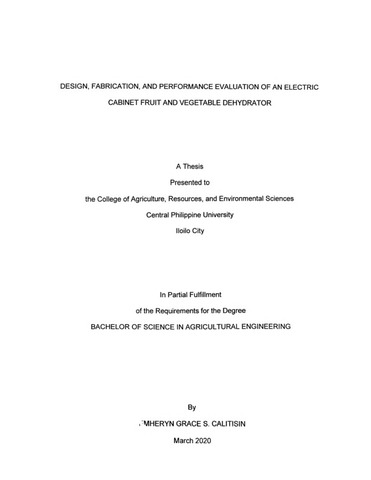Design, fabrication, and performance evaluation of an electric cabinet fruit and vegetable dehydrator
| dc.contributor.adviser | Romallosa, Aries Roda D. | |
| dc.contributor.author | Calitisin, Emheryn Grace S. | |
| dc.date.accessioned | 2021-07-14T07:28:11Z | |
| dc.date.available | 2021-07-14T07:28:11Z | |
| dc.date.issued | 2020 | |
| dc.identifier.citation | Calitisin, E. G. S. (2020). Design, fabrication, and performance evaluation of an electric cabinet fruit and vegetable dehydrator (Unpublished Thesis). Central Philippine University, Jaro, Iloilo City. | en_US |
| dc.identifier.uri | https://hdl.handle.net/20.500.12852/1187 | |
| dc.description | Abstract only | en_US |
| dc.description.abstract | The design of cabinet fruit and vegetable dehydrator aimed to reduce the moisture content of the commodity to lengthen its shelf life while the quality of the product is maintained. It is composed of the following main parts: a) Dehydrating chamber where samples were subjected to dehydration, b) machine frame that served as the framework, c) heat source chamber with incandescent bulbs and auxiliary fans, d) exhaust where excess heat flows out, e) glass door for easy viewing, f) removable trays for easy access and g) temperature controller. It was completed within 4 months including the modifications, pre-testing and final evaluation. It has an overall dimension of 40 cm L x 40 cm W x 40 cm H. The commodities included were banana and mango for fruits, while chili pepper and carrots for vegetables. The machine produced an average dehydrating capacity of 81.33 g/hr, 113.67 g/hr, 44 g/hr and 53.33 g/hr for banana, mango, chili pepper and carrots, respectively. It also obtained a moisture reduction rate of 47 g/hr, 85.67 g/hr, 37.2 g/hr and 48.83 g/hr, respectively. The dehydrating efficiency of the machine ranges from 4.85% to 11.27%, which is too low according to PAES that is 75%. It is due to high amount of heat loss produced during the conduct of the study. Based on the data, the machine produced a moisture loss which ranges from 48.22 % to 75.58 %. The average score obtained from four commodities during the organoleptic test was 4.14, which indicated that the dehydrated products were acceptable. Its operating cost as computed were PHP0.67/g, PHP0.48/g, PHP1.24/g and PHP1.03/g for banana, mango, chili pepper and carrots, respectively. | en_US |
| dc.format.extent | ix, 50 leaves | en_US |
| dc.language.iso | en | en_US |
| dc.rights | Attribution-NonCommercial-NoDerivs 3.0 Philippines | * |
| dc.rights.uri | http://creativecommons.org/licenses/by-nc-nd/3.0/ph/ | * |
| dc.subject.ddc | Filipiniana Theses 630.72 C129 | en_US |
| dc.subject.lcsh | Dried fruit | en_US |
| dc.subject.lcsh | Dried vegetables | en_US |
| dc.subject.lcsh | Food--Drying | en_US |
| dc.subject.lcsh | Drying apparatus | en_US |
| dc.subject.lcsh | Food--Drying--Equipment and supplies | en_US |
| dc.subject.lcsh | Drying apparatus--Design and construction | en_US |
| dc.subject.lcsh | Drying apparatus--Evaluation | en_US |
| dc.title | Design, fabrication, and performance evaluation of an electric cabinet fruit and vegetable dehydrator | en_US |
| dc.type | Thesis | en_US |
| dc.description.bibliographicalreferences | Includes bibliographical references | en_US |
| dc.contributor.chair | Cabarles, Jaime C. Jr. | |
| dc.contributor.committeemember | Patricio, Hope G. | |
| dc.contributor.department | College of Agriculture, Resources and Environmental Sciences | en_US |
| dc.description.degree | Bachelor of Science in Agricultural Engineering | en_US |



